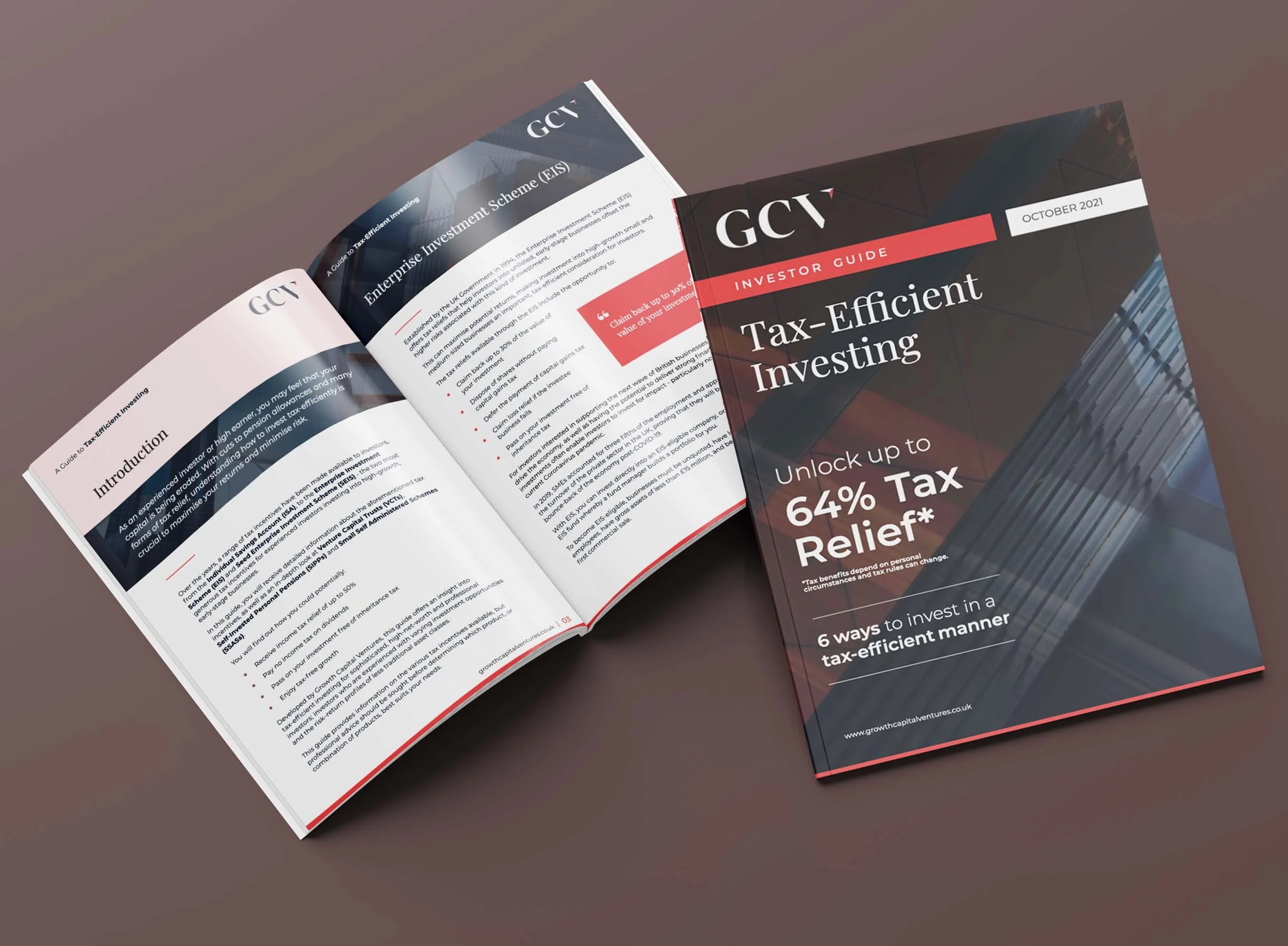
EIS Tax Reliefs
For UK investors utilising the Enterprise Investment Scheme (EIS) when investing in early stage companies, a host of generous tax reliefs can be claimed to aid in minimising risk and maximising returns.
Firstname Lastname & Firstname Lastname
Position & Position, Company
Which Tax Reliefs does the EIS Offer?
5 Key Tax Advantages
From 30% income tax relief to capital gains tax exemption, the broad range of tax advantages available to investors under the enterprise investment scheme is among the most generous to exist in the UK venture capital space and stands out among other venture capital schemes. This powerful array of benefits acts as a strong incentive for investment, attracting not only traditional investors but also angel investors who are keen to support early-stage startups.
Alongside minimising the risk and maximising the returns associated with early-stage investments in startups, these five tax reliefs can help craft a diversified investment portfolio, play a key role in future tax plans and even help provide an accessible inroad to impact investing.
1. Income Tax Relief
30% Income Tax Relief up to £600,000
Arguably the best EIS tax relief, investors can claim up to 30% income tax relief on investments up to £1 million per tax year (extending to £2 million should all investment over the original threshold be invested into knowledge-intensive companies [KICs]) should shares be held for at least three years.
Reducing some of the risk traditionally associated with investing in early-stage companies and startups by claiming a proportion of the investment back in income tax relief, this advantage alone offers investors the potential to claim up to £600,000 back in tax per annum (providing income tax eligibility criteria is met). This tax benefit is a significant incentive for many who are keen to invest in promising startups through the enterprise investment scheme.
As well as being able to claim income tax relief for the year that the investment was made, through EIS carry back relief, should an investor instead wish to treat the 30% relief as if it was made in the previous tax year (to suit personal tax planning circumstances) they can do so.
EIS Income Tax Relief Example
Should an investor pledge £50,000 into an EIS investment opportunity, once their EIS3 certificate has been received (distributed upon the issuing of shares and often following advance assurance from HMRC confirming eligibility), they will be able to claim up to £15,000 of that sum back via a deduction from that or the previous tax year's income tax bill.
Claiming EIS income tax relief is a relatively straightforward process that can be completed by either applying for and filing a self-assessment tax return (should you pay tax solely through PAYE), or by entering the details of your EIS3 form upon completion of an annual tax return (if you are a business owner or self-employed).
2. Tax-Free Growth
Capital Gains Tax Exemption
EIS capital gains tax relief offers investors the opportunity to generate considerable tax-free growth over time by making any gains realised on EIS shares 100% CGT-free at the point of disposal (a relief shared by its sister scheme, the Seed Enterprise Investment Scheme).
Negating the usual UK CGT liability of 18% for basic rate taxpayers (or 18% for property sales) and 24% for higher/additional rate taxpayers (still 24% for property sales) due upon the point of disposal, EIS CGT exemption can act as a powerful advantage for maximising returns when compared to many traditional equity routes. When investing in the enterprise investment scheme, investors in startups can especially benefit from this tax relief, securing considerable gains over time.
CGT Exemption Example
Should an investor pledge £50,000 in an EIS investment opportunity, and their shares be valued at £150,000 upon the point of disposal, the £100,000 gain (that would usually be liable to a £24,000 deduction) will be completely capital gains tax-free. (Assuming a capital gains tax rate of 24%.)
In order to qualify for EIS capital gains tax exemption, shares must have been held for at least three years from either the date of issue or commencement of trading (whichever is later), and the company must remain EIS eligible for at least that three-year period.
When claiming EIS capital gains tax relief, the gain does not need to be included in your usual disposal proceeds (being an exempt gain and automatic relief), but the details should be included in the 'Any other information' section of your capital gains summary form should you file an annual tax return.
3. Capital Gains Tax Deferral
Defer CGT Due on the Sale of Other Assets
One of the lesser-known, but perhaps most advantageous of the EIS's tax reliefs, EIS deferral relief allows investors to defer a payment of CGT that has arisen from the sale of any other asset (providing the gain is invested into EIS investment opportunities). This relief is particularly beneficial for those who sell other assets and reinvest into startups, as it enables them to manage tax liabilities more effectively under the enterprise investment scheme.
This effectively means that investors can treat gains they have acquired from shares, property sales, or any other chargeable asset as though they had been acquired in future years, offering investors the power to reorganise their tax liabilities to best make use of annual tax allowances and personal circumstances.
CGT Deferral Example
Should a higher/additional rate taxpayer sell a property and make a capital gain of £100,000, where usually that individual would be required to pay £24,000 of their gain in CGT (24% on property), EIS deferral relief will allow them to receive the full sum of the gain and defer the CGT due to a later year.
In order to qualify for deferral relief, HMRC states that the gain must be invested into EIS-eligible shares within one year prior or three years after it arises. The gain will cease to be deferred when the EIS shares are sold, and there is no upper limit to the value of gains that can be deferred.
To claim EIS deferral relief you can either complete the claim form attached to your EIS3 certificate and attach this to the capital gains summary page of your annual tax return (should you be eligible for one), or by completing a HMRC online self-assessment form should you PAYE, stating your wish to defer the gain.
4. Inheritance Tax Relief
Shares Passed on Inheritance Tax Free
Another tax advantage shared by both the EIS and SEIS, inheritance tax relief allows investors to pass on EIS shares inheritance tax-free, without being liable to the usual 40% IHT rate due in the UK on estates valued over £325,000.
A powerful tool for minimising inheritance tax liabilities when planning for later life - providing the investment was made at least two years before passing - EIS IHT relief has the potential to minimise capital erosion and maximise the proportion of an estate that is inherited. Investors in startups, including angel investors, can use this relief to preserve wealth across generations.
If you're unsure whether your estate will be subject to significant taxation at this stage, our inheritance tax calculator can help with non-complex situations.
IHT Exemption Example
Should an investor who has exceeded the £325,000 IHT nil-rate band pledge £200,000 in EIS shares two years before passing, rather than having to forfeit £80,000 of that sum in inheritance tax (mandatory under certain savings accounts), they can pass the full value of their shares on IHT and CGT free.
IHT relief is obtained by claiming business relief (BR). A claim for BR is normally made during the settlement of the shareholder’s estate, whereby the executors will need to complete a copy of the probate return form IHT 412 and return this to HMRC as part of the overall probate process. HMRC will then assess the claim.
5. Loss Relief
Minimising the Risk of Early Stage Investments
Among the less understood of the enterprise investment scheme's tax reliefs, EIS loss relief provides investors with a safety net should an unexpected event arise with their portfolio company, offering them the ability to offset any potential loss realised on their EIS investment against their marginal rate of income tax or capital gains tax.
By offsetting a potential loss against their income tax bill for the current or previous tax year, or instead against their CGT bill for the current or future years, loss relief allows investors to mitigate some of the risk associated with investing in startups. This can be especially reassuring for angel investors actively involved in early stage startups who seek to manage risks while enjoying significant tax benefits avaliable.
Loss relief is calculated by multiplying your effective loss (the value you originally invested minus the return you realised and the value of income tax relief you claimed) by either your marginal rate of income tax or rate of capital gains tax (dependent on which route you choose). An EIS calculator can also be used to calculate how you could benefit from this relief.
EIS Loss Relief Example
Should a higher rate taxpayer investor invest £50,000 in an EIS opportunity, of which they have already claimed £15,000 back in income tax and only realised £5,000 in returns, they could then multiply their effective loss of £30,000 by their 45% rate of income tax to claim back a total of £13,500 in loss relief.
Though there are a number of caveats to be aware of when claiming EIS loss relief, essentially investors can claim loss relief by completing the SA108 form on their annual tax return. To report on this section, investors must complete the 'Unlisted shares and securities' section, stating the effective loss to offset against income.
Enterprise Investment Scheme (EIS)
Investor Guide
- Claim 30% income tax relief on the value of your investment
- Pay zero capital gains tax when selling EIS shares
- Defer existing capital gains tax liabilities to later years
- Pass on shares free of inheritance tax
- Claim loss relief should an unexpected event arise
And also explains:
- How to invest using the EIS
- What type of companies you can invest in using the EIS
- How the EIS can contribute to a diversified portfolio
- The risks and returns associated with the EIS
- The most frequently asked questions surrounding the EIS

Submit the form to get your free guide
EIS Tax Relief FAQ
How Can EIS Loss Relief Minimise My Investment Risk?
While investing in early-stage startups inherently carries some level of risk, EIS loss relief provides a substantial safety net. Angel investors in particular appreciate this scheme, as it offers them a clear path to recover a portion of their investment if a startup underperforms. If a company in your portfolio doesn’t perform as expected, loss relief allows you to offset any losses against your income tax or capital gains tax bill, helping you recover a significant portion of your investment.
How Can EIS Help with Long-Term Wealth Management and Tax Planning?
EIS offers more than just short-term tax reliefs—it can play a key role in long-term wealth management and tax planning. Beyond the immediate benefits like income tax relief and capital gains tax exemption, EIS investments allow for flexibility in managing your tax liabilities. For example, through the deferral of capital gains from other assets, you can spread out tax payments over several years, aligning them with your personal financial goals.
Additionally, inheritance tax relief provides the opportunity to pass on EIS shares without any liability to IHT, making EIS a powerful tool for building and preserving family wealth. This comprehensive approach is particularly appealing to angel investors and others looking to invest in startups via the enterprise investment scheme.
A tool like an EIS calculator can prove useful when tax planning or deciding how to manage your investments.
How Do I Track and Claim Tax Reliefs Across Multiple EIS Investments?
If you make multiple EIS investments in different companies or through a fund, you can still track and claim EIS tax relief for each one. You’ll receive an EIS3 certificate for each investment, which you’ll need to claim the associated tax benefits. To simplify the process, you can enter the details from each certificate into your self-assessment tax return.
Should you invest through an EIS fund, the fund manager will typically provide the required documentation once the investments are made. Keeping clear records of all your EIS investments ensures you can easily track and claim the full range of tax reliefs, from income tax relief to capital gains tax exemption.
Can I Invest in Both EIS and SEIS in the Same Tax Year?
Yes, you can invest in both EIS and SEIS in the same tax year and take advantage of the different tax reliefs each scheme offers. The SEIS is designed for even earlier-stage companies than the EIS, and while it has a lower maximum investment limit (£100,000 per tax year), it offers a higher rate of income tax relief (50%). You can split your investments between the two schemes, benefiting from both SEIS and EIS tax advantages while potentially diversifying your investment portfolio between startups at different stages.
However, it’s important to track your investments to ensure you’re making the most of the available reliefs under each scheme.
Are There Any Restrictions on the Types of Assets Whose Capital Gains Can Be Deferred Through EIS Deferral Relief?
EIS deferral relief applies broadly to any chargeable asset, which means you can defer capital gains from shares, property, or other assets when reinvesting the gain into EIS-eligible shares. However, there are no specific restrictions on the types of assets you can defer from, but it is essential to ensure that the gains are reinvested within the stipulated timeline—either one year before or three years after the gain is realised.
It is also worth noting that while the deferral of capital gains is possible, the relief will only last until the EIS shares are sold or become non-eligible, at which point the deferred gain becomes chargeable.
How Soon Can I Claim EIS Tax Relief After Investing?
You can claim EIS investment tax relief as soon as you receive your EIS3 certificate, which is issued once the company has either been trading for at least four months or has spent 70% of the invested funds. The timing of this process can vary depending on the company’s operational status and how quickly they meet these criteria. Once you have the EIS3 certificate in hand, you can proceed to claim your tax relief, optimising your investment benefits efficiently. Obtaining advance assurance from HMRC prior to the investment can also streamline this process, ensuring that your shares qualify under the enterprise investment scheme.
The GCV Portfolio
Our Most Recent EIS-eligible Opportunities
Having raised over £10 million across EIS-eligible investment rounds for a broad range of portfolio companies, at GCV we possess a wealth of experience in originating and facilitating growth-focused, impact-driven EIS investment opportunities.

Growth Capital Ventures
| Sector: | Fintech |
|---|---|
| Target Sought: | £ 750,000 |
| Round: | Round 4 |
| Investment Type: | Equity |
| Tax Schemes: | EIS |

Business Finance Market (trading as Finance Nation)
| Sector: | Fintech & Banking |
|---|---|
| Target Sought: | £ 249,999 |
| Investment Type: | Equity |
| Tax Schemes: | EIS |

Hive.Hr
| Sector: | HR Tech |
|---|---|
| Target Sought: | £ 150,000 |
| Funds Raised: | £ 303,000 |
| Round: | Round 1 |
| Investment Type: | Equity |
| Tax Schemes: | EIS, SEIS |

Intelligence Fusion
| Sector: | SaaS |
|---|---|
| Target Sought: | £ 400,000 |
| Funds Raised: | £ 556,800 |
| Round: | Round 1 |
| Investment Type: | Equity |
| Tax Schemes: | EIS, SEIS |

Hive.Hr
| Sector: | HR Tech |
|---|---|
| Target Sought: | £ 300,000 |
| Funds Raised: | £ 1,150,000 |
| Round: | Round 2 |
| Investment Type: | Equity |
| Tax Schemes: | EIS |

QikServe
| Sector: | Fintech |
|---|---|
| Target Sought: | £ 2,500,000 |
| Funds Raised: | £ 2,624,694 |
| Round: | Round 1 |
| Investment Type: | Equity |
| Tax Schemes: | EIS |

n-gage.io
| Sector: | SaaS |
|---|---|
| Target Sought: | £ 150,000 |
| Funds Raised: | £ 170,000 |
| Round: | Round 1 |
| Investment Type: | Equity |
| Tax Schemes: | EIS, SEIS |

Business Finance Market (trading as Finance Nation)
| Sector: | Fintech & Banking |
|---|---|
| Target Sought: | £ 150,000 |
| Funds Raised: | £ 225,000 |
| Round: | Round 1 |
| Investment Type: | Equity |
| Tax Schemes: | EIS, SEIS |

Growth Capital Ventures
| Sector: | Fintech |
|---|---|
| Target Sought: | £ 500,000 |
| Funds Raised: | £ 561,000 |
| Round: | Round 1 |
| Investment Type: | Equity |
| Tax Schemes: | EIS, SEIS |

Growth Capital Ventures
| Sector: | Fintech |
|---|---|
| Target Sought: | £ 1,000,000 |
| Funds Raised: | £ 1,290,410 |
| Round: | Round 2 |
| Investment Type: | Equity |
| Tax Schemes: | EIS, SEIS |

Business Finance Market (trading as Finance Nation)
| Sector: | Fintech & Banking |
|---|---|
| Target Sought: | £ 1,000,000 |
| Funds Raised: | £ 800,000 |
| Round: | Round 2 |
| Investment Type: | Equity |
| Tax Schemes: | EIS |

Finexos
| Sector: | Fintech & Banking |
|---|---|
| Target Sought: | £ 500,000 |
| Funds Raised: | £ 695,456 |
| Round: | Round 3 |
| Minimum Investment: | £ 500 |
| Investment Type: | Equity |
| Tax Schemes: | EIS |

Business Finance Market (trading as Finance Nation)
| Sector: | Fintech & Banking |
|---|---|
| Target Sought: | £ 250,000 |
| Funds Raised: | £ 278,855 |
| Round: | Round 3 |
| Minimum Investment: | £ 1,000 |
| Investment Type: | Equity |
| Tax Schemes: | EIS |

Growth Capital Ventures
| Sector: | Fintech |
|---|---|
| Target Sought: | £ 1,000,000 |
| Round: | Round 3 |
| Minimum Investment: | £ 5,000 |
| Investment Type: | Equity |
| Tax Schemes: | EIS |

n-gage.io
| Sector: | SaaS |
|---|---|
| Target Sought: | £ 500,000 |
| Funds Raised: | £ 638,961 |
| Round: | Round 2 |
| Investment Type: | Equity |
| Tax Schemes: | EIS |

Finexos
| Sector: | Fintech & Banking |
|---|---|
| Target Sought: | £ 1,309,999 |
| Round: | Round 5 |
| Investment Type: | Equity |
| Tax Schemes: | EIS |
Minimise Risk. Maximise Returns.
Latest Updates
From tax efficient investing to joint venture property investing, our blog is full of news, information and insights.

EIS deferral relief: how can you benefit as an investor?


EIS capital gains tax relief: an overview for investors

Subscribe
Let's keep in touch
To keep up to date on news, events and investment opportunities, sign up to our newsletter here.
* You can unsubscribe at any point using the link provided in the footer of all emails, for more information about how we handle data you can view our privacy policy.
%20(3)%20(2).jpg)
